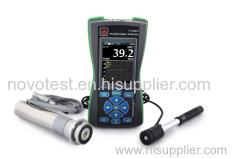
Combined Hardness Tester NOVOTEST T-UD3
| Min. Order: | 1 Set/Sets |
|---|---|
| Trade Term: | FOB,CIP |
| Payment Terms: | T/T, Money Gram |
Company Profile
| Location: | Ukraine |
|---|---|
| Business Type: | Manufacturer |
Product Detail
| Means of Transport: | Air |
|---|
Product Description
Combined Hardness Tester NOVOTEST T-UD3
The device operates with both UCI (Ultrasonic Contact Impedance) and Leeb (dynamic) probes. User get the benefits of two methods of measurement – it is the maximum that can be obtained from portable hardness tester.
UCI method for the hardness testing
The ultrasonic contact impedance (UCI) probe is used for measuring the hardness of small items, objects with a thin wall, complex form, and to measure the hardness of surface hardened layers.
Universal portable hardness tester T-UD3 use the UCI method for the hardness measuring, which is standardized according to ASTM A 1038. This method allows user to measure very fast and easy: install the probe on tested object, press on the probe with required effort and after that save the results of the hardness value, which are showed on the display of the device. Diamond indenter has a small size that allows user to measure hardness value of all samples, which are thicker than 1 mm. The UCI method of hardness testing is the least destructive method because the hardness tester T-UD3 leaves much smaller stamps than leaves the bench hardness tester. That's why portable hardness tester T-UD3 is very useful and universal.
Leeb method for the hardness testing
Leeb probe is used for measuring the hardness of non-ferrous metals, cast iron, coarse-grained materials, massive products etc.
Hardness tester T-UD3 also use a dynamic method of the hardness measuring – Leeb method, which is standardized according to ASTM A956. This method allows user to measure very fast and easy: install the probe, press on the probe to recharge spring, press the button on the top of the probe to make test and after that save the results of the hardness value, which are showed on the display of the device. This method is used for measuring the hardness value of non-ferrous metals, cast iron, coarse-grained materials, massive products etc. (with weigh more than 5 kg or thicker than 10 mm) also this method perfectly complements the UCI method of hardness measuring. Hardness tester T-UD3 makes automatic calculation of the hardness of a wide range of materials – steel, stainless steel, cast iron, bronze, aluminum, so that we can say that combined hardness testers is the most universal, which is needn't in recalibration, and fully ready for operation after "getting out of the box".
During the hardness testing, user can take a picture of the sample and print the results of hardness measurements on some place on the photo of sample.
Saved results of measurements in the device can be transmitted to a PC for creating a report of testing in a specialized program – "ARM", which supplied with the hardness tester.
Hardness tester allows user to measure the hardness at extremely low temperatures. The real tests has been carried out at a temperature of 25°C below zero. The device is operated very easy, the measurement accuracy did not exceed the value according to standards, keyboard and display of the device allowed user to operate confidently – the difference between the operating at the indoor temperature and operating at the extreme cold was not noticeable at all!
We have the CE certificate of conformity for Portable Combined Hardness Tester NOVOTEST T-UD3.
Advantages:
Small imprint after measuring (mirror surfaces of shafts necks, blades, gear teeth, etc.)
Measuring the hardness of the surface hardened layer
Wide range of hardness testing
Various measurement modes
88 combinations of materials and hardness scales (calibrations)
Calibration of any scale in any range
Convenience and ease of measurement
Optimized number of buttons
Large full color graphic display with bright backlighting
Photofixing of measuring samples
Automatic recognition of probe
Indication of the type of connected probe
Calibrations stored in memory of UCI probe
Extended temperature range (frost, down to – 40°C)
Internal memory and communication with PC
New intuitive menu with tips on the buttons
Optional wireless mini printer
Water resistant case
Rubber bumper protected case
Internal clock
Measure hardness value of any mass products with a thickness more than 1 mm (small parts, thin-walled structures, pipes, tanks, steel sheets, articles of complex shape, hardness testing of metal coatings, etc.)
The device has different operating modes:
Graph – the mode of building of graph
Histogram – the mode of building of histogram
Statistics – the mode of statistic
Smart – the mode of filtering of incorrect measurements
Signal – the mode of displaying of signal (only for Leeb probe)
Specifications:
| UCI probe types | 1kgf (10N) 2.2 lbf, 5kgf (50N) 11lbf, 10kgf (98N) 22lbf |
| Leeb probe types | D, DC, DL, C, D+15, E, G |
| Measuring range | HV:230~940; HRC:20~70; HB:90~650. Tensile strength, MPa 370~1740 |
| Measuring accuracy | HV:±3%HV; HRC:±1.5%HRC; HB:±3%HB |
| Indenter | Diamond indenter (UCI), Hardened ball (Leeb) |
| Measuring direction | Any direction 360° |
| Data storage | Limited only by the memory card |
| Communication | Upload data to PC and export as a spreadsheet (USB cable and software included ) |
| Hardness scale | HRC, HB, HV, HRB, HS, HL, MPa |
| Materials |
|
| Data display | Load applied/contact (UCI), Angle (Leeb), Single test result, Max, Min, Average of tests, Number of tests, Deviation, Var. coeff, Histogram, Signal and Smart Mode (Filter of incorrect measurements). |
| Indication | Color LCD display (320×240) |
| Operating environment | Temperature:-20°C~40°C; Humidity: 30%~80%R.H. |
| Power supply | DC 4,5V (3 pcs batteries AA) |
| Instrument dimensions | 160x75x30mm |
| Net weight | Approx. 0.3kg (without probe) |
| Battery life | Approx. 10 hours. |
Standard set includes:

